“Suddenly the sky went dark. So dark, the lights in school had to be put on. It started to rain heavily and then the most violent storm started – that in itself was frightening enough but what was about to happen was a terrifying experience.” Ruby Currell recalled the moments before Classy Chassis II, a B-24H Liberator from BAD-2, tragically fell out of the sky into the heart of Freckleton village. 61 people would lose their lives, 38 of which were children from the local school, on a day which will be remembered for generations.

The morning of Wednesday August 23rd, 1944, had begun like many others at BAD-2. Night shifts changed over with the day cover, and flight control prepared for the day of flying ahead. 1944 was the busiest year at BAD-2, with August seeing roughly 80 flight movements a day. 627 of these flights were local clearances, predominately test flights from the air base taking place before the aircraft ferried to their respective units. At 10:30am B-24H Liberator “Classy Chassis II” “42-50291” was cleared for take-off for her test flight, at the controls was 1st Lieutenant John A Bloemendal, with Technical Sergeant James M Parr as co-pilot and Sergeant Gordon W Kinney in the Flight Engineer’s seat. Not far behind Classy Chassis II was B-24 Liberator “42-1353” flown by 1st Lieutenant Pete Manassero, with his crew of Lawrence Smith and Dick Pew. Both aircraft received their clearances and took off from Warton, heading for their flights over Lancashire
Soon after take-off Bloemendal radioed Manassero, drawing his attention to a heavy cloud formation to their South-East. Less than five minutes after the aircraft had left BAD-2, a telephone call reached the base from General Ott at BAD-1 Burtonwood, warning of a violent storm approaching the area. At approximately 10:40am, Flight control ordered the pair of Liberators to return to Warton, clearing them for landing on runway 08.
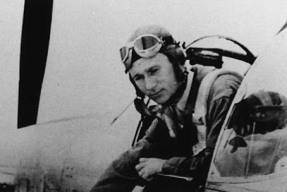
As the Liberators arrived overhead, the storm was at its most fierce. Witnesses recall seeing waterspouts in the Ribble estuary and up-rooted trees. The skies turned dark. As lights flicked on indoors the only thing illuminating the streets of Freckleton were the streaks of lightning tearing through the sky. Witnesses recall sheltering from the storm, unable to see much further than a few feet ahead of them. The aircraft lowered their landing gear and turned to line up for BAD-2’s runway 08, flying 100 yards apart. At an altitude of 500ft, the bombers encountered driving rain and strong gusts of wind. Soon, the aircraft would lose visibility of each other on their approach.
Although the official report states that no further radio contact was made by Bloemendal with Control, radio conversations monitored by Warton’s tower indicated that the two B-24 pilots had abandoned their attempts to land and were heading North to hold clear until the storm abated. Manassero retracted his landing gear and climbed out of his approach, he took a heading which flew him and his crew clear of the storm. As soon as he cleared the storm, Manassero radioed Bloemendal to no reply. Radio transmission attempts from both Manassero’s Liberator and BAD-2’s flight control continued with no response from Bloemendal’s aircraft.
Eight year old Eric Greenwood witnessed the ill-fated aircraft as it came to earth. “I saw the Liberator and heard its roar right over the house. It was flying very low and I saw the right wing go down as the left came up. It seemed to be swaying in the air. I saw no flames. A moment afterwards I heard a crash.” Classy Chassis II came in low, its wings near vertical as it ripped the top off a tree and struck the corner of a building. After losing a wingtip, it began to tear through the ground. The aircraft, laden with thousands of gallons of fuel on board, cartwheeled through two houses and the Sad Sack snack bar; the wreckage then slid across Lytham Road into the infant’s wing of Freckleton Holy Trinity School. The entire area burst into flames as the fuel from the aircraft engulfed the scene.
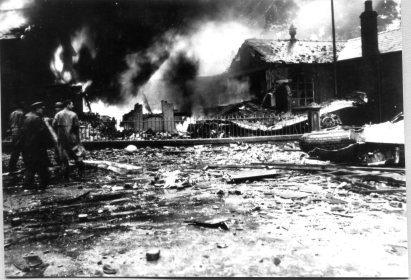
The sound of the crash brought a rush of soldiers, police and villagers. Calls were sent out to the depot fire-station and the local stations of the National Fire Service. The storm raged on as rescue attempts began. Servicemen and villagers fought the fire with what they could to no avail, the intense heat from the inferno holding them back. Crews from BAD-2’s fire service arrived at the scene at 10:48am to utter devastation; it would be 20 minutes before the first National Fire Service crews would arrive. For those 20 minutes four pieces of BAD-2 fire apparatus fought back the flames, as off duty crews were rushed in to assist. The storm then quickly subsided, the rescue efforts soon became a search for those they knew could not have been saved. Fire crews remained on duty until 7pm “when the fire had been extinguished and all hope of further resources from the wreckage was abandoned”. The rescue work carried on into the night, with the aid of searchlights previously positioned around BAD-2.
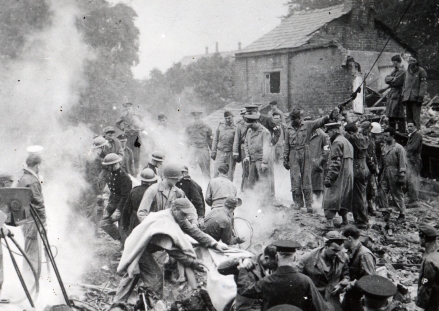
What remained could only be described as devastation. Only three children escaped the infant’s wing of the school alive, leaving behind 35 children and two teachers. The Sad Sack snack bar took the full force of the crash, leaving several civilians, six USAAF, and four RAF personnel amongst the casualties. All three crew members of Classy Chassis II lost their lives on impact. Several of the more seriously injured victims died during the following week and when the formal inquest into the tragedy opened on September 8th 1944, the total death toll was 61.
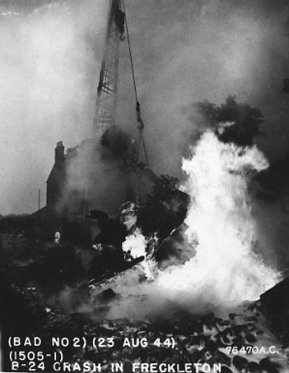
The funeral service took place in Freckleton on August 26th. The majority of the child victims along with Miss Jenny Hall, a teacher and local girl who had arrived at the Freckleton School only the day before the accident, as well as a number of civilians killed in “The Sad Sack” Snack Bar, were buried in a communal grave in the village’s Holy Trinity Churchyard. The streets of the village were lined with mourners, often standing six deep, as the procession passed. Personnel from BAD-2 carried the caskets to their final resting place, whilst more USAAF G.I’s assisted with the burial. Hundreds of floral tributes surrounded the grave site. The three airmen from the Liberator were buried in a United States cemetery in the South of England, before being later returned to their home states in the U.S. at the request of their next of kin.

A memorial fund was set up by the USAAF at BAD-2. Personnel from the air base soon began work transforming an area of land nearby into a memorial garden and children’s playground. The US servicemen raised the money for the equipment on the playground, which was dedicated in August 1945, with a stone tablet bearing the inscription: “This playground presented to the children of Freckleton by their neighbours of Base Air Depot No. 2 USAAF in recognition and remembrance of their common loss in the disaster of August 23rd 1944”
The official report into the crash summarised that the exact cause was unknown, though it was the opinion of the Investigating committee that the pilot made an error in his judgment of the violence of the storm. They concluded that Lt. Bloemendal had not fully realised the danger until he made his approach to land, by which time he had insufficient altitude and speed to manoeuvre given the violent winds and downdrafts he must have encountered during his attempt to withdraw from the area.
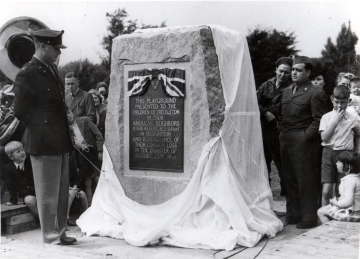
The disaster was one of the worst air accidents in Britain during World War II, with the one of the largest civilian casualty counts outside of the German bombings. USAAF airmen would go on to be trained about the dangers of British thunderstorms before heading over the Atlantic, and further measures were introduced at BAD-2 to help prevent anything like this happening again. Further memorials to the disaster have since been erected in the village, and memories of the crash still resonate amongst the community.
This piece would not have been possible without the hard work of the Lancashire Aircraft Investigation team. For more information visit: http://laituk.org/B-24%2042-50291.htm

Hello, my grandad was married to Evelyn Rhodes who was an employee at the Sad Sack Cafe and unfortunately died. Would love to hear from anyone involved
LikeLike
Hello, my aunty was Evelyn Rhodes, my mum’s sister. The family moved back to Elworth, Sandbach, Cheshire after the disaster. Evelyn had two sisters and a brother, who was killed in the war in 1944. Her brother was called Herbert Counsell.
LikeLike
Today in Freckleton was the memorial service of the air disaster. A service is held every year, but was all the more poignant today marking the 75 th anniversary 😦
I have some photos of the memorial taken today. If anyone would like to see them, find me on Facebook ….. Jacqueline Davis….. kirkham and message me ❤
LikeLike
On that morning I was on my bike heading to the cafe where they had slot machines .The rain came down like stair rods as I sheltered under the CO OP veranda . I headed for my aunts house in Bush lane and we were looking out of the window when the house shook and flames lit up the dark Sky in the distance ,My Aunt thought that the Germans had bombed the Shipyard where her son worked . At about midday my mother came to collect me but was sure I had perished in the crash . As we neared the bottom of Clitheroes Lane the road was a mass of fire hoses running from the mill lodge towards the school . In the afternoon I sat with some of my pals on the church wall completely unaware of the seriousness of the tradgedy. Later we looked in the band room behind The Coach & Horses where we saw the body bags of those who had died . Recently I met a lady in the memorial garden who was the girlfriend of the American Pilot and she lived in Lytham at that time but had moved to Blackpool later .
LikeLike
My mum, Sheila Vickers, was in the school that day and she survived because the classroom holding the older children was barely damagex. Sadly just the other side of mum’s classroom housed the younger children and most of them were killed. Mum doesn’t know how she got out through the rubble and fires.
Mum was 10 at the time and is now 84 she finds it very difficult to talk about the disaster and is still.terrified when there are violent thunderstorms raging.
This year commemorates the 75th Anniversary of that day and I wonder how many survivors are still with ux.
LikeLike
Peter Vickers – Your mother was a very good friend of my mother, Doreen (Broadbent) Thias. Do you have a brother Stephen?
Wendy Thias
LikeLike
My boss,Margaret Mason also escaped the fire, she was one of the first to run to safety, she attended the memorial service today and said it was very emotional
LikeLike
Yes I know Margaret very well. I was born and grew up in Freckleton. I remember the morning of the disaster being all dark, noisy and smoky and never to forget even though I was only 3 1/2 years old.
Please say hello to your mum from me.
I’ve lived in the USA for the last fifty years.
LikeLike
I grew up in Freckleton down Preston Old Road and was 3 1/2 at the time of the disaster.
I knew your mum as Sheila Burns and she was a friend of my cousin Megan Webster.
I remember being rushed up to the school with my mum and grandmother amid all the smoke and noise. Please say hi to your mum. I have lived in the USA for the last fifty years and return home every year.
LikeLike
Hi Sheila I believe my grandad Maurice Battersby your half cousin small world
LikeLike
My Grandad Maurice Battersby was there at school on that day , my grandad had a message for another teacher ( cant remember which class room) think top class of the infant side, went in classroom but got told off by the teacher was told to knock before entering the classroom, my grandad closed the door knocked and opened the door as the plane crashed in the classroom, unfortunately the teacher was on fire couldn’t be saved but he remembered he helped a girl out of the window , very brave my hero still here till this day 23rd August never to be forgotten!!
Unfortunately I don’t remember the name of the young girl my grandad helped to rescue
LikeLike
I knew Maurice quite well. I was borne in Preston Old Road. I vaguely remember the morning of the disaster, I was only 3 1/2 years old, it was dark, smoky and noisy.
Please say hi to your grandad from me. I have lived in the USA for fifty years and return home every year.
LikeLike
Hello apologies for late reply!!
I will mention you when I can next visit him hope your well
LikeLike
On the morning of the crash. I was riding my bicycle heading for the cafe where they had penny slot machines. The rain came down like stair rods as I sheltered under the Co- op canopy .
I decided to go to my aunts house in Bush Lane and as we looked out at the dark sky the ground shook and the sky was lit up by flames in the distance . My aunt thought that the Germans must have bombed the shipyard where her son worked. Near midday my mother came and found me . She thought I had perished in the cafe . As we neared the end of Clitheroes Lane the road was covered in hose pipes from the Mill Lodge to the school .
Later that afternoon I sat with some pals on the church wall unaware of the real tradgedy
Which had happened a few yards away . Later that afternoon we saw the body bags in the band room behind the Coach & Horses .
Recently I met a lady from Lytham in the memorial garden who was the girlfriend of the pilot
LikeLike
I am looking for more information regarding Freckleton at the time that B.A.D was stationed there between 1942 and 1945. I myself lived in Freckleton between 1964 and 1992 but I was a babe-in-arms when we first moved there. I believe my day moved us there as he was in the RAF at the time, and I think Freckleton would have reminded him of an RAF type base as there were so many Nissen Huts etc. I am also trying to find out what was Trufresh (egg packing station before Trufresh took it over)? Was that part of the USAAF base
LikeLike
I was born in Freckleton in 1941 in the end cottage opposite Freckleton
Sports & Social club. I can vaguely remember the morning of the crash. A very dark, stormy and noisy morning as my mother and grandmother ran uptown with me in the pram. The school walls were down and there were heaps of rubble, smoke and fire everywhere. No more remembrances after that. I do remember Ruby (born Whittle) . The only egg packing station I remember was Yates where the Freckleton club now stands. I’ve lived in the USA the last fifty years but visit home every year.
LikeLike
My father’s older brother, Samuel Mezzacappa (Age 20, in 1944) was stationed in Wharton with the USAAF. He was inside the Sad Sack Cafe when it was hit. I never met him, and the USAAF, never gave any details to my grandmother (she passed 1976) at the time. I have the original Western Union Telegrams. I am the last in the line of my family. I have no cousins and my dad has passed (died 1993). If anyone can share anything please find me on Facebook AnnMarie Mezzacappa Buontempo. Thank you.
LikeLike
I’m learning more about my Great-Grandad (Eddie ‘Ed’ Stinger, the father of Johnny Philip Stinger, who was once a member of the BAD-2 Association) and something I learned was his experience of the disaster. He was an American G.I. who was driving a jeep to Preston on the day it happened, he said he saw the crash happen in front of him. He rushed to the door of Holy Trinity Church to try to get it open but couldn’t due to the rubble on the other side. Then two other people came to help him (one of them being the headmaster) and together they got it open far enough for Eddie to get inside. He saw an infant girl (Ruby Currell) aflame and used his coat to put the fire out. He took her outside where medics had arrived who took her from him. Then he helped other American servicemen catch children being thrown over a High School Wall. He visited Ruby all the time and read dozens of books to her as she recovered.
He was injured in 1948 from landmine shrapnel in Germany and sent back to Warton. The plane taking him back crashed into the English Channel and he spent 2 days floating. He was rescued but had to have his leg amputated. He was taken back to Pittsburgh, PA and died in 1995
LikeLike
I was four yrs old that and saw the airoplane lit up by lightening my brother Teddy delivered meat in Freckleton We saw smoke and flames in the distance somy brother sat me in the basket in front of his bike and we went into the village and saw it all The American soldiers were wrapping bodies covered in oil and they wereputting them in ambulances. One may ask !How can i remember …I can never forget.Veronica Walsh.
LikeLike
Is this the same Veronica Walsh who lived in San Francisco 1965??
LikeLike
My grandad James Reginald Slater and his sister Evelyn Slater went to the school. My grandad is no longer with us but would love to find anyone that remembers either him or his sister 💕
LikeLike
Sadly my grandad Maurice has passed away in January may he rest in peace xxxx
LikeLike
Hello Hannah,
I’m very sorry to hear of the passing of your grandfather.
I knew him well and what a kind gentleman he was.
LikeLike
Thank you so much , he sure is thank you for your kind words
LikeLike
I’m just wondering whether there is any documentary or film about the disaster?
LikeLike
https://laituk.org/B-24%2042-50291.htm
”In 2007 we received a request from the BBC to assist in the production of a short documentary for their Inside Out – North West program and as such recognition of the disaster was, we felt long overdue, we agreed to participate. The piece was aired on Friday January 26, 2007 and also involved Ruby Currell, one of only three children to survive from the infants classroom and local man Harry Latham who was in a different classroom on that day and now tends the communal grave in Holy Trinity churchyard. The documentary was well received, if perhaps a little short considering the subject matter, though it was very well put together and certainly got the message across despite this. However, one comment that arose during filming was that there was nothing today to mark the actual site of the tragedy and the residents of Freckleton very quickly picked up on this, resulting only a few months later in the unveiling, on Monday 30th April 2007, of the bronze plaque below.”
LikeLike
Thank you will try and retrieve documentary thank you
LikeLike
My Nan survived the disaster because she was off school ill that day. She told me of the horrors and I attended the new Freckleton primary school. My Nan’s name is Olive Reynolds if anyone remembers her.
LikeLike